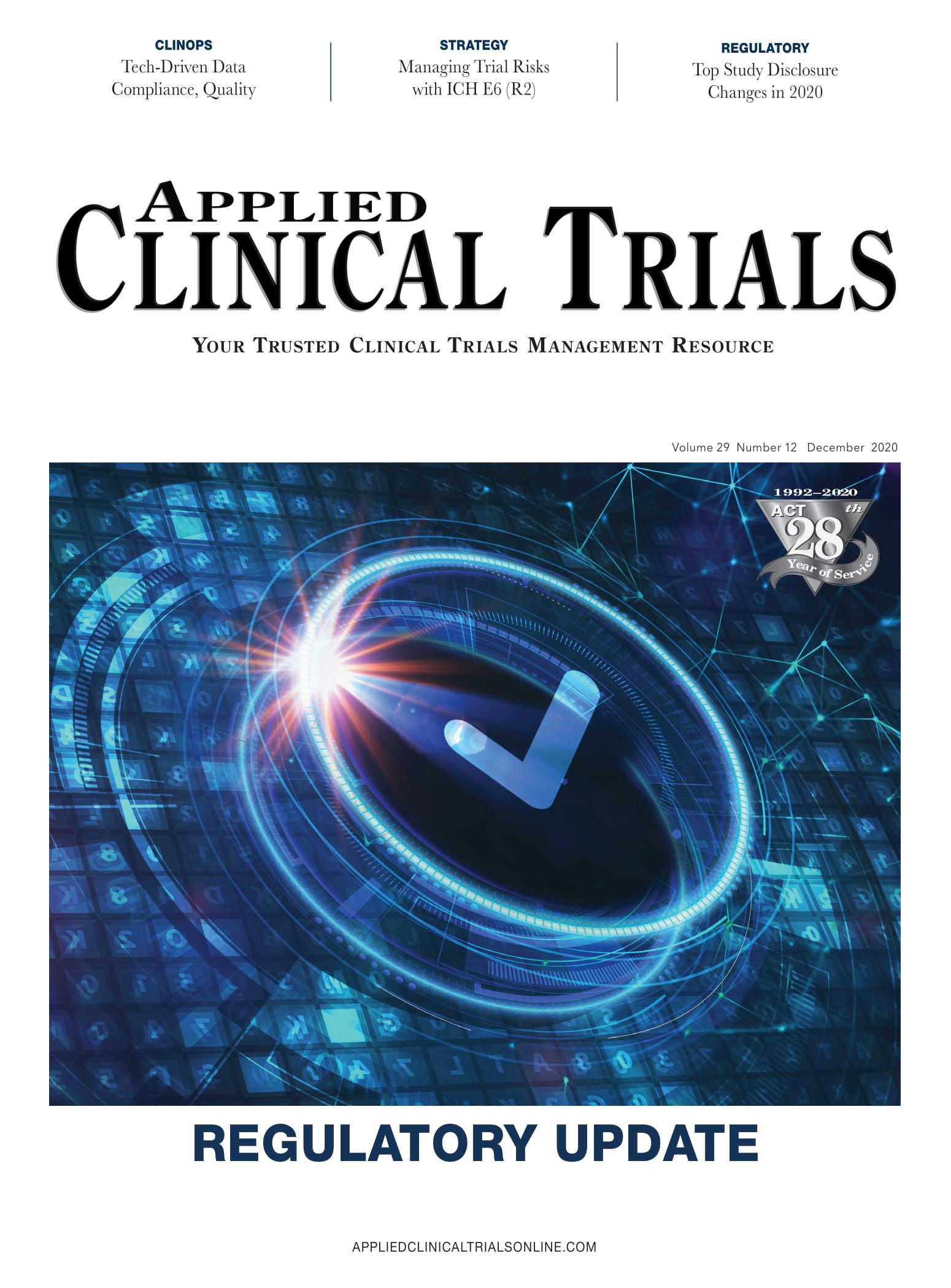Managing Risks in Clinical Trials During a Pandemic with ICH E6 (R2)
COVID-19 pandemic forces compliancy within organizations following FDA’s 2018 revision of Good Clinical Practice in federal registry.
Marina Acosta Enslen

In March 2018, FDA placed ICH E6 (R2), a revision to Good Clinical Practice (GCP), in the federal registry. This regulatory update made explicit the responsibility of the sponsor to understand the risks to quality in clinical trials via the use of a Risk-Based Quality Management (RBQM) approach. Consisting of a variety of required components–including but not limited to quality risk assessments, a written Quality Risk Management Plan, and strategic, centralized data reviews–the revision underscores the importance of a robust RBQM framework to ensure clinical trial execution in compliance with GCP.
In the months since ICH E6 (R2) was adopted, a global pandemic has impacted clinical trial operations. However, even before the pandemic, many companies were still working to become compliant–and while COVID-19 has introduced its share of roadblocks to the industry, it has also prompted sponsors to intentionally embrace the adoption of a RBQM framework to new and ongoing trials.
In this article, we will examine the overall value of ICH E6 (R2) to sponsors, as well as how COVID-19 has and will continue to influence sponsors’ consideration of risk-based monitoring as a key component of clinical trial operations.
Benefits to ICH E6 (R2) and an RBQM framework
Early, targeted risk assessment tells you where you need to look and watch. In other words, to adopt a RBQM framework means to focus more on what matters most: the critical data/processes and potential risks unique to each trial. As the foundation for a targeted, risk-based approach to monitoring, RBQM helps sponsors first identify and understand their trials’ most critical risks before choosing the monitoring strategy that provides the most value.
So, what exactly does ICH E6 (R2) ask of sponsors, and what benefits does it offer in return for the time invested in making the transition? As it currently stands, ICH E6 (R2) requires sponsors to implement the following:
- Quality risk assessments, starting at protocol development and ending with database lock
- A written RBQM Plan and demonstration of plan execution
- Strategic data reviews throughout the clinical trial
- A robust RBQM framework and approach to ensure regulatory compliance
While these additional assessments and reviews may seem overwhelming at first glance, it is important to consider these requirements alongside the benefits they provide:
- Improves the likelihood of a high-quality clinical trial
- Ensures clinical trial execution in compliance with GCP
- Focuses on data and risks critical to trial endpoints and patient safety
- Provides quick access to data insights across clinical sites and patients
- Potentially reduces the amount of on-site monitoring needed
The risks of foregoing an RBQM framework
In efforts to adapt the ICH E6 (R2) revision, many companies have encountered difficulty transitioning to a risk-based approach and adaptive monitoring strategy. However, the potential risks that could result from foregoing an RBQM framework far outweigh the transitional period.
For sponsors still weighing the necessity of adopting a RBQM approach, it is important to recognize that the decision to skip proactive, risk-based monitoring brings a risk to safety, data integrity, and even primary endpoints, any of which could drastically impact trials if not monitored appropriately.
Likewise, clinical trials characteristically produce massive amounts of data for study staff to sift through. However, if they have not proactively identified key data and processes that could bring potential risk, they run the danger of getting “lost in the weeds” and overlooking risk factors that later breached tolerance limits and resulted in issues that had some level of impact on the study and its results.
Employing the expertise of a CRO is an option for sponsors to help alleviate the work and time commitment required to adopt a RBQM process on their own. At Rho, we consider a robust RBQM framework to include dedicated quality risk managers, RBQM templates to assist with creating the plans required by ICH E6 (R2), a strategic approach to data review, among other components.
COVID-19, ICH E6 (R2) and a risk-based future
The global pandemic is a major risk in and of itself, and it has certainly revealed the extent of its negative impact on a variety of industries, resulting in closures, layoffs and more. When observed through a clinical research lens, COVID-19 is the type of risk that should be accounted for proactively–ideally via an RBQM approach. However, the reality is the shocking and surprising onset of the pandemic did not provide the clinical research industry–or any industry–the foresight to prepare for every single roadblock presented by a pandemic of this scale.
For many ongoing clinical trials, when the pandemic hit, sites stopped seeing patients in-person, encountered issues with enrollment, along with other delays. This required sponsors to pause and identify what risks COVID-19 could bring about to potentially impact the future of the trial. Arguably, this situation has forced sponsors to look at their trials through an RBQM lens and adopt this process or encounter the risk of halting their trials altogether.
On the other hand, those in the planning phase have the privilege of incorporating pandemic-related mitigations into their programs up front.
During this stage, an early adoption of RBQM provides the opportunity to proactively determine what can be monitored centrally or conducted remotely via on off-site visit or very limited on-site visits to safeguard patient and staff health and safety.
Overall, ICH E6 (R2) underscores the sponsor’s responsibility to evaluate and implement risk-based monitoring into their clinical trials, before, during and even after the era of COVID-19. We consider a risk-based future to consist of the following:
- Site monitoring visits conducted based on tracking and managing risk at the site
- Initial set of visits may be pre-planned but then visits are driven by findings–leading to a variable frequency of visits across the study and between sites
- More findings or more severe findings leads to more visits and vice versa
- Visit types (off- or on-site) driven by number, severity, and type of findings
It is important to note that the possibility of more on-site visits will likely be delayed as we continue to adapt and recover from the impacts of COVID-19. However, decentralized clinical trials provide a viable solution for this setback, as long as they are patient-centric, customized and rooted in a robust RBQM framework, per the ICH E6 (R2) guidance.
Conclusion
Arguably, the global pandemic has redefined our understanding of a “traditional” clinical trial, as more sponsors are implementing decentralized clinical trials to keep studies active during this time. Despite this shift, many organizations have still been slow to adopt ICH E6 (R2) and make the necessary updates. Future updates to ICH E6 (R2) will likely be driven by this need for more frequent adoption of the revisions, as well as pave the way for an easier industry-wide transition to a risk-based monitoring approach.
Marina Acosta Enslen, Associate Director, Clinical Management, Rho

Funding Cuts Threaten Diversity in Clinical Research
June 27th 2025In this video interview, Kyle McAllister, co-founder, CEO, Trially, discusses how recent federal funding cuts are likely to undermine research focused on underrepresented populations, and why long-term investment in community-based studies is essential to closing persistent health equity gaps.
Unifying Industry to Better Understand GCP Guidance
May 7th 2025In this episode of the Applied Clinical Trials Podcast, David Nickerson, head of clinical quality management at EMD Serono; and Arlene Lee, director of product management, data quality & risk management solutions at Medidata, discuss the newest ICH E6(R3) GCP guidelines as well as how TransCelerate and ACRO have partnered to help stakeholders better acclimate to these guidelines.
FDA to Launch National Priority Voucher Program to Speed Drug Reviews for Critical Therapies
June 18th 2025Under the new initiative, companies may receive a voucher enabling FDA review to be shortened from the standard 10–12 months to just 1–2 months following final application submission if the drug addresses US national health priorities.